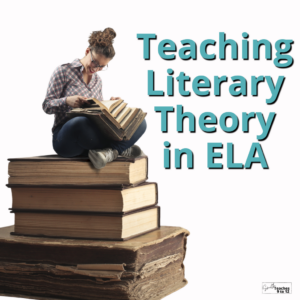Ever wondered why we interpret a novel the way we do? Literary theory opens up a whole new lens for understanding literature. It’s like slipping on different glasses to see the same story from multiple perspectives. In English Language Arts (ELA), literary theory is more than just an academic exercise—it’s a vital tool that turns readers into thinkers.
Why Literary Theory Matters in ELA

Critical Thinking Skills Development
Teaching literary theory is like giving students a mental gym membership. It forces them to flex those critical thinking muscles. Instead of passively consuming stories, they start asking why characters act a certain way or how society shapes narratives.
Enhancing Textual Analysis
Theory deepens textual analysis. Suddenly, a simple story isn’t just a story—it’s a reflection of historical struggles, gender dynamics, or economic power structures. This layered reading transforms students into analytical powerhouses.
Core Literary Theories to Teach
Formalism/New Criticism
Formalism focuses purely on the text itself—structure, style, and language. Think of it as treating the book like a puzzle to be solved, without worrying about the author’s life or the historical background.
Reader-Response Theory
Here, the reader’s interpretation reigns supreme. It’s like saying, “Your experience with the text matters just as much as what the author intended.” It’s incredibly empowering for students.
Marxist Criticism
Ever notice how some characters seem to have it all, while others struggle? Marxist criticism dives into class struggles and economic inequalities. Perfect for connecting literature to the real world.
Feminist Criticism
Through a feminist lens, students explore gender roles and representation. Who has a voice? Who is silenced? It’s eye-opening and super relevant in today’s world.
Postcolonial Criticism
Postcolonial theory examines power, culture, and identity after colonization. It invites students to think about whose stories are told and whose are erased.
When to Introduce Literary Theory in the Classroom
Middle School vs High School Considerations
Middle schoolers can start with basic concepts through storytelling and guided discussion. High schoolers? They’re ready to dive deep into complex theories with independent analysis and debate.
Strategies for Teaching Literary Theory
Start with Familiar Texts
Before tossing “The Scarlet Letter” at them, start with something they know—fairy tales, popular novels, or even movies. It’s way easier to discuss feminism in “Cinderella” than in Hawthorne’s Puritan world (at first, anyway).
Use Visual and Multimedia Resources
YouTube explainers, movie clips, infographics—use whatever it takes to make abstract theories concrete. Sometimes a short animated video explains Postcolonialism better than a hundred pages of text.
Encourage Discussion and Debate
Get students talking! Group discussions, fishbowl activities, and Socratic seminars let them wrestle with the theories out loud, building understanding organically.
Activities to Make Theory Fun and Engaging
Literary Theory Role-Play
Assign each student a theoretical lens. When you discuss a story, they must defend it through their assigned theory. It’s like a courtroom drama but way nerdier—and way more fun.
Create a Literary Theory Journal
Ask students to keep a journal where they reflect on texts through different theoretical lenses. Over time, they’ll see patterns and deepen their interpretations.
Common Challenges and How to Overcome Them
Student Resistance
Some students might say, “Why do we have to overthink everything?” Meet them where they are. Show them that these theories aren’t about ‘ruining’ books—they’re about uncovering hidden treasures.
Complexity of Concepts
Theory can feel overwhelming. Break it down into bite-sized lessons and use plenty of examples. Think scaffolding, not sink-or-swim.
Assessing Students’ Understanding of Literary Theory
Creative Projects and Essays
Instead of boring tests, have students create podcasts, visual essays, or storyboards analyzing a text through a specific theory. Creativity = engagement + deeper understanding.
Benefits Beyond the Classroom
College Readiness
Colleges love students who can think critically and write persuasively. Literary theory is basically brain training for higher education.
Empathy and Worldview Expansion
Reading through different lenses helps students understand perspectives different from their own. It’s not just about better grades—it’s about becoming a better human.
Conclusion
Teaching literary theory in ELA doesn’t have to be dry or intimidating. With the right strategies, it becomes a vibrant, exciting journey into the world of ideas. Students not only learn to read differently—they learn to think differently. And honestly, what could be more powerful than that?

